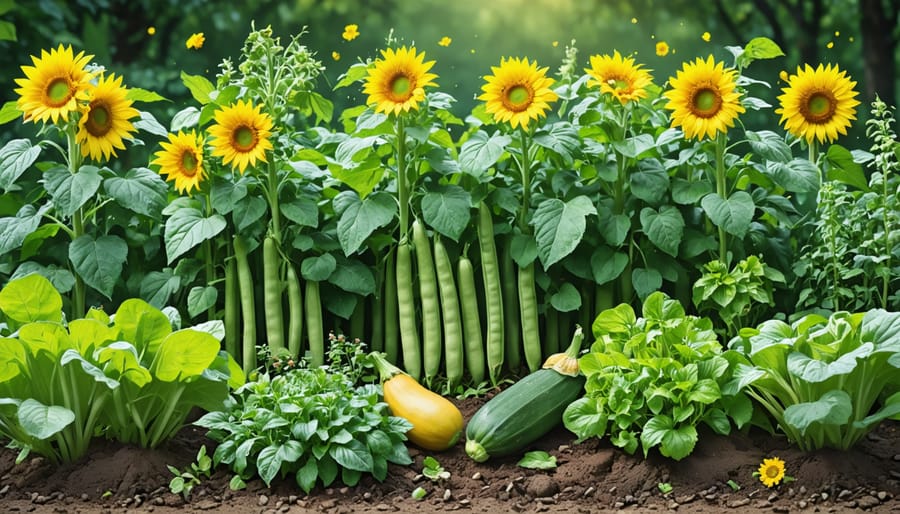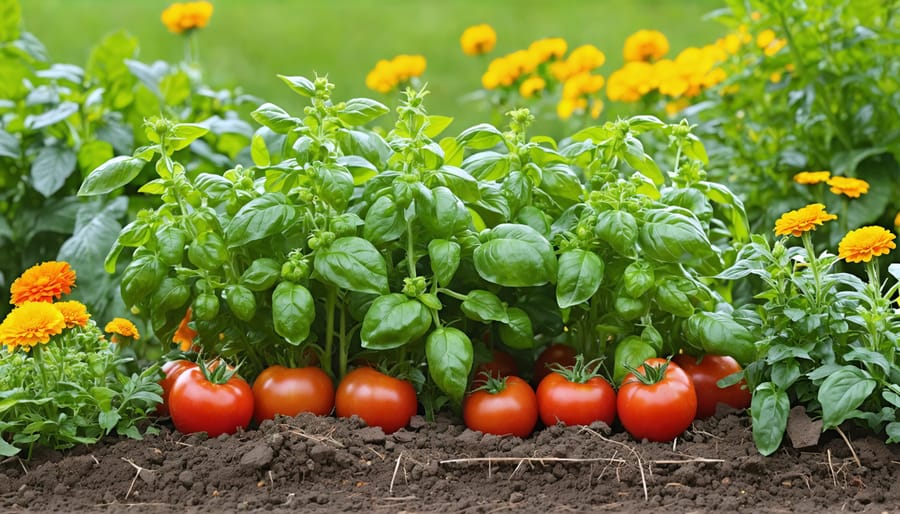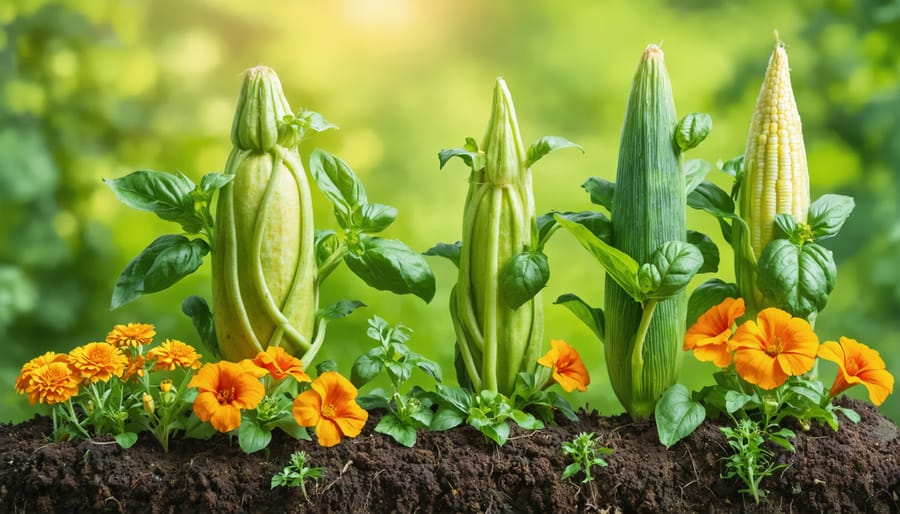Transform your bean garden into a thriving ecosystem by strategically pairing your beans with companion plants that enhance growth, deter pests, and boost yields naturally. Companion planting charts serve as essential roadmaps for creating resilient garden layouts that work with nature, not against it. Whether you’re growing bush beans or pole varieties, understanding which plants make good neighbors can mean the difference between a modest harvest and an abundant one.
This comprehensive guide reveals time-tested plant partnerships that maximize your garden space while building climate resilience. From aromatic herbs that repel bean beetles to flowers that attract beneficial pollinators, you’ll discover how to create powerful plant communities that support each other through changing weather patterns. Learn which combinations to embrace – like the classic Three Sisters planting of beans, corn, and squash – and which to avoid, ensuring your bean patch thrives even in challenging conditions.
Why Climate-Smart Bean Companion Planting Matters
Temperature Management Through Plant Partners
Companion planting isn’t just about pest control – it’s also a clever way to create a comfortable microclimate for your beans. Tall, leafy plants like sunflowers and corn can act as natural windbreaks, protecting delicate bean seedlings from harsh breezes. Low-growing, spreading plants such as squash and cucumbers create living mulch that helps maintain soil moisture and regulate temperature around your beans’ roots. During hot summer days, herbs like basil and mint can provide partial shade, while their aromatic leaves help retain humidity. For cooler climates, try planting marigolds nearby – their dense foliage traps heat and creates warm pockets that beans love. Remember to leave enough space between plants to maintain good air circulation, preventing humidity-related issues while still benefiting from these natural temperature controls.
Water Conservation Partnerships
Creating a moisture-friendly environment around your beans can significantly boost their growth and resilience. Plants like squash and pumpkins work as living mulch, their broad leaves shading the soil and reducing water evaporation. Corn, a traditional companion in the “Three Sisters” planting method, provides natural support while creating a humid microclimate that benefits beans. Low-growing herbs such as oregano and thyme form dense ground covers that help retain soil moisture and reduce watering needs. Consider adding leafy greens like Swiss chard or spinach nearby, as they contribute to overall humidity levels while making efficient use of water resources. Together, these companions create a water-wise garden ecosystem that helps your beans thrive with less irrigation.

Best Climate-Resilient Companions for Beans
Heat-Tolerant Companions
When temperatures soar, your beans need sturdy companions that can handle the heat while maintaining beneficial relationships. Some of the best vegetable combinations for weather resilience include sunflowers, which provide natural shade and support for climbing beans while thriving in warm conditions. Peppers make excellent companions too, as they share similar temperature preferences and don’t compete for nutrients.
Sweet potatoes work wonderfully alongside beans in hot weather, creating ground cover that helps retain soil moisture and suppress weeds. Their sprawling growth pattern complements the vertical nature of bean plants, making efficient use of garden space. Eggplants are another heat-loving option that pairs well with beans, as both crops benefit from similar watering schedules and soil conditions.
Consider adding drought-resistant herbs like oregano and sage to your bean beds. These Mediterranean herbs not only tolerate high temperatures but also help repel certain pest insects that might trouble your beans during hot spells. Their shallow root systems won’t interfere with your beans’ growth, making them perfect neighbors in challenging weather conditions.

Drought-Resistant Partners
When drought conditions threaten your bean garden, certain companion plants can help create a more resilient growing environment. Amaranth serves as an excellent drought-resistant partner, with its deep roots helping to maintain soil moisture and provide natural mulching. Its tall structure also offers partial shade to bean plants during intense heat.
Sunflowers make fantastic drought-tolerant companions, as their large leaves help shade the soil and reduce water evaporation. Their extensive root systems can access water deep in the soil, improving moisture retention for nearby beans. Plant them on the north side of your bean patch to avoid overshadowing.
Consider adding herbs like oregano and sage, which not only tolerate dry conditions but also help create a humid microclimate that benefits beans. These Mediterranean herbs require minimal water and their aromatic properties can help deter certain pests.
New Mexico chiles and tepary beans have traditionally been grown together in desert conditions for centuries. This time-tested combination works well because both plants have adapted to thrive in hot, dry conditions while supporting each other’s growth.
Remember to mulch around these companion plantings to maximize water retention and maintain soil moisture during dry spells.
Wind Protection Companions
When growing beans, protecting them from strong winds is crucial for their healthy development. Tall, sturdy plants can serve as excellent windbreaks, creating a more favorable microclimate for your bean plants. Corn makes an outstanding wind protection companion, as its tall stalks naturally shield bean plants while also providing support for climbing varieties.
Sunflowers are another excellent choice for wind protection. Plant them on the windward side of your bean patch to create a natural barrier. Their thick stalks and broad leaves work together to diffuse strong gusts, while their height provides extended protection for your growing beans.
Jerusalem artichokes can form an impressive seasonal windbreak, growing up to 10 feet tall. These hardy plants establish themselves quickly and create dense growth that effectively blocks wind while attracting beneficial pollinators to your garden.
Consider planting rows of amaranth as well. This versatile plant not only provides good wind protection but also offers edible leaves and seeds. Its sturdy stems hold up well against strong breezes, making it an ideal companion for protecting more delicate bean plants.
For a permanent solution, consider establishing a row of perennial herbs like rosemary or sage along the windward edge of your garden. These aromatic plants create a low-lying windbreak perfect for bush bean varieties while adding diversity to your garden ecosystem.
Remember to space your wind protection companions far enough from your beans to prevent competition for nutrients while still providing adequate shelter.
Planting Layout Strategies
Spacing and Positioning
Proper spacing is crucial for successful bean companion planting, and the arrangement patterns vary depending on your climate zone. In warmer regions, space bush beans 4-6 inches apart in rows with 18-24 inches between rows to allow for adequate air circulation and reduce moisture-related diseases. For pole beans in these areas, create wider spacing of 6-8 inches between plants with 36 inches between rows.
In cooler climates, you can plant beans slightly closer together, as disease pressure from humidity is typically lower. Consider using the classic Three Sisters planting method, where corn provides natural support for climbing beans, while squash spreads below to shade the soil.
For raised beds in any climate, utilize square-foot gardening principles: plant bush beans in grids of 9 plants per square foot, or 8 pole beans around a central support structure. When interplanting with companions like marigolds or nasturtiums, maintain a 6-inch buffer around bean plants to prevent competition for nutrients.
Remember to adjust these spacing guidelines based on your specific microclimate and seasonal variations. In areas with strong winds, consider planting beans closer together or creating windbreaks with taller companion plants to protect your crop.

Seasonal Planning
Successful companion planting with beans requires careful timing throughout the growing season. For spring plantings, start by sowing radishes and lettuce about two weeks before your beans. These fast-growing companions will be ready to harvest just as your bean plants reach maturity, maximizing your garden space.
When planting summer combinations, wait until the soil has warmed to at least 60°F (16°C) before sowing beans alongside heat-loving companions like corn and squash. This traditional “Three Sisters” grouping works best when corn is planted first and reaches about 6 inches tall before adding beans and squash.
Fall planning requires particular attention to timing. Plant quick-maturing bush beans in late summer alongside cool-season crops like spinach and carrots. These companions will continue growing after your beans finish producing, extending your harvest season.
For year-round success, consider succession planting with your companions. Start a new batch of compatible herbs like basil or dill every 3-4 weeks throughout the growing season. This ensures continuous harvests and maintains beneficial insect populations that protect your bean plants.
Remember that timing may need adjustment based on your local climate and weather patterns. Keep a garden journal to track successful companion combinations and their optimal planting times in your specific growing zone.
As we’ve explored throughout this guide, companion planting with beans isn’t just about maximizing space – it’s about creating resilient gardens that can withstand our changing climate. By strategically pairing your beans with compatible plants, you’re not only improving yields but also building a more sustainable and adaptable garden ecosystem.
Remember that successful companion planting starts with observation and experimentation. While our chart provides excellent starting points, don’t be afraid to try new combinations based on your local climate conditions. Keep notes on what works best in your garden, and adjust your planting strategy accordingly.
As weather patterns become more unpredictable, these time-tested companion planting techniques become increasingly valuable. Whether you’re growing bush beans alongside aromatic herbs or letting pole beans climb up corn stalks, you’re participating in an age-old practice that’s more relevant than ever.
Start small, perhaps with just a few companion pairs, and gradually expand as you gain confidence. Your garden will thank you with better harvests, fewer pest problems, and improved soil health. Happy planting!




